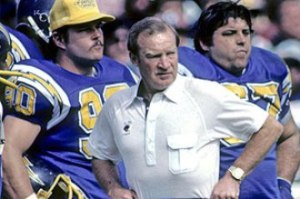-
Don Coryell was a communications genius, although he wasn’t a professional communicator. He was a football coach, a coach who revolutionized how offenses are run in football. Coryell recently passed away at the age of 85, and Sports Illustrated took the occasion to run a major piece on his contribution to the game in their July 12, 2010 edition. Professional communicators, particularly those who design web sites, could learn a lesson from the man.
What made him so unique? Coryell (the communicator) devised a very effective play-calling method for his players (his audience) when he was the head coach at San Diego State for 12 seasons (1961-72). It enabled his offenses to discern and run very intricate plays with a minimum of information. Football players have very little time between plays to process information. When it’s late in the game and the weather is lousy and the fans are loud, those elements can further complicate the ability to communicate. In order to be successful, each of the 11 guys on the field has to understand their individual assignment on each play. One mental mistake by one guy can be the difference in a play that results in a positive net gain or a loss – or even worse, a turnover!
Here’s what he did. Prior to Coryell, offensive plays were referred to by a formation plus a name for the play. For example, “Power I Maverick.” “Power I” referred to the formation and “Maverick” was the play. You certainly hoped your guys had memorized the playbook! The SI article goes on to describe how Coryell’s system was brilliant and why it has stood the test of time. In football, teams often use two wide outs, in football speak referred to as the X and Z receivers. Another receiver, called the split end because he plays close to the line, is often called the slot receiver and is designated by the letter Y. So, you have the X, Y and Z receivers. With me so far?
 Coryell devised a numbering system to identify pass routes for those receivers. Let’s use the example of the play here, the 525 F Post Swing (image left). According to Sports Illustrated, “Routes for the outside receivers in a formation (the X and Z receivers) were assigned single digits, from 1 to 9; routes for an inside (or Y) receiver were assigned multiples of 10, from 10 to 90.” The numbers corresponded to different pass routes. For the X and Z receivers, a 1 route is a curl route, a 2 is a basic out, a 3 is a skinny post, etc. The route list for the Y receivers were assigned multiples of 10. And the route descriptions are precise! All a wide receiver had to memorize, however, was what pass patterns 10 digits corresponded to, not memorize a whole playbook the size of a metropolitan phone book.
Coryell devised a numbering system to identify pass routes for those receivers. Let’s use the example of the play here, the 525 F Post Swing (image left). According to Sports Illustrated, “Routes for the outside receivers in a formation (the X and Z receivers) were assigned single digits, from 1 to 9; routes for an inside (or Y) receiver were assigned multiples of 10, from 10 to 90.” The numbers corresponded to different pass routes. For the X and Z receivers, a 1 route is a curl route, a 2 is a basic out, a 3 is a skinny post, etc. The route list for the Y receivers were assigned multiples of 10. And the route descriptions are precise! All a wide receiver had to memorize, however, was what pass patterns 10 digits corresponded to, not memorize a whole playbook the size of a metropolitan phone book.
Getting back to our example, the play called 525 F Post Swing, the X and Z receivers run a 5 route (a 15-yard comeback) and the Y receiver runs a 20 route, a shallow cross. “F Post” just gives the F position, which in this example is a running back, directions to run a post pattern. “Swing” refers to the formation the team should line up in. Not that hard, right? Every play was built from the foundation of the digits.
The key was Coryell’s system was visual, not cognitive. As quarterback Trent Green said in the article, “It was always a great thing for me… The first thing I do when a play comes into my headset is visualize it. In this system, with every play call, you’re actually telling everybody what to do by what you say. Instead of saying, ‘I Right Omaha,’ you’re saying, ‘R 428 H Stop,’ and that tells everybody what to do, instead of relying on their memorization.”
Simply put, Coryell designed a way to make it easy for his audience to understand his message. He had high respect for them and figured out a way for them to get his message easily, with a minimum of effort. He didn’t leave them to figure it out. In his profession, it enabled his football teams to run very complex plays – and win a lot of games! He was way ahead of his peers. Tony Dungy, winner of Super Bowl XLI as the coach of the Indianapolis Colts, told SI, “Super Bowls count so much now; that’s all anyone talks about. But if you talk about impact on the game, training other coaches – John Madden, Bill Walsh, Joe Gibbs to name a few – and influencing how things are done, Don Coryell is probably right up there with Paul Brown. He was a genius.”
Sadly, Coryell isn’t in the NFL Hall of Fame yet. Two coaches who were once his assistants, Madden and Gibbs, already are. The only thing Coryell lacks on his resume is a championship. His contribution to the game is already legendary.

0 Responses to “Don Coryell: Communications Genius (1924-2010)”